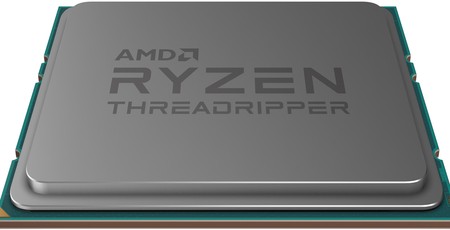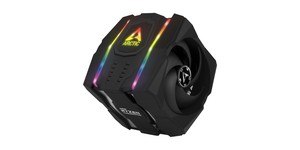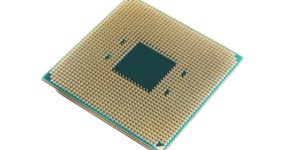
Overclocking
Starting with the Threadripper 2920X, we managed to hit an impressive 4.2GHz across all 16 cores with a vcore of 1.425V with its big brother, which was tamed by our 240mm AIO liquid cooler and offered a decent multi-threaded performance boost. However, we could only hit 4.1GHz with the same voltage on the 12-core CPU, which is also 100MHz below its maximum boost speed, albeit the latter isn't applied across all cores.
The Threadripper 2970WX also managed 4.1GHz, but this was 100Mhz lower than we managed with the 2990WX. We also had to reign in the vcore to 1.41V to bring temperatures to within acceptable levels else under full loads they'd skyrocket.
Performance Analysis
We'll start with the Threadripper 2920X again and AMD continues to offer significantly better value than Intel's HEDT CPUs, with a sizeable advantage in HandBrake at stock speed and only a small deficit once we'd overclocked the CPUs. Given the $300 price difference and similar platform costs, it's fairly clear who's the winner here. It was the same in Cinebench, Blender and POV-Ray and in most of those, the 2920X's additional cores and threads counted for a lot more thanks to HandBrake's poor scaling, and even when overclocked the Core i9-7900X couldn't keep up.
However, the Core i9-9900K is definitely a threat. In HandBrake, the AMD CPU was just five percent quicker, albeit this rose to 15 percent in Cinebench, but still, the 2920X costs 12 percent more and that's before you factor in spending a lot more on your motherboard and memory too. Games are still leaving an advantage to Intel and again, the Core i9-9900K is even more of a threat here, outstripping the Threadripper 2920X in every test.

We should point out that we've retested the 2990WX with the newer Nvidia drivers that fix a bug that saw gaming performance cut dramatically, so if you're wondering why that CPU suddenly performs better in our game tests, you know why. The 2970WX performed as expected outside of workstation tasks, often sitting below the Threadripper 2920X in the graphs thanks to the fact that 12 of its 24 cores cannot directly access the rest of the system, instead, relying on Infinity Fabric - a setup that's clearly hindering things in a lot of software.
Switch to the likes of POV-Ray, Blender and Cinebench, though, and the Threadripper 2970WX is a monster. it outstrips the Core i9-7980XE by huge margins in all those benchmarks and even when overclocked only gets close in Blender - quite damning when you consider its $700 dollar price premium. That is until you get to games, where the Intel CPU proved its worth as an all-rounder, with much better frame rates in Deus Ex and Ashes of the Singularity as well as better scores in the 3DMark tests.
AMD has released a beta version of its new Ryzen Master software that brings with it a new dynamic memory access mode that forces threads to be assigned to the cores on local-access dies first. It's an interesting if partial solution to the problem and while we had very little time to test it, didn't seem to make a massive difference in many tests. HandBrake saw no improvement and still wasn't able to match the 16 cores of the Threadripper 2950X. However, we saw a massive 13 per cent boost in Far Cry 5, with the minimum frame rate rising from 41fps to 46fps. Deus Ex also saw an increase with the minimum frame rate rising from 44fps to 50fps and average from 67fps to 70fps.
Conclusion
The Threadripper 2920X is an additional nail in the coffin for the lower half of Intel's high-end desktop CPUs that are made to look like particularly poor value by this $600 CPU, with their only real advantage being in games. It offers a huge cost-saving compared to the Core i9-7900X, although given the $250 price difference, we'd probably opt for the Threadripper 2950X, which not only offered a little more overclocking headroom, but significantly more multi-threaded grunt to see off the threat from Intel's Core i9-9900K. The latter really does make for a compelling choice here given the significantly lower platform cost and much better gaming performance and only losing out by wider margins in workstation workloads. Again, you lack the benefits of the X399 platform such as quad-channel memory and additional PCIe lanes, but if you just want decent gaming and multi-threaded performance and don't have a need for multiple GPUs and the like, it's definitely a strong option.
The Threadripper 2970WX is a beast when all of its cores and threads can be fully utilised but this remains a niche venture that's limited to workstation workloads. Games and content creation often take a hit due to its internal makeup and the new Ryzen Master software with dynamic local access mode offered mixed results, with big boosts in some games, but not helping much in other applications and still being some way behind the Threadripper 2950X in the games we tested - it was better but still not on par. Once again, then, we must stress that as an all-round CPU, it's not the best option, with the vast majority of its praise falling on its performance in workstation applications, where it offers unbeatable value compared to Intel. With the blue team seemingly not offering much more than a frequency bump and return to solder with its upcoming HEDT CPUs, Threadripper, with both the X-series and WX-series, looks set to continue being a thorn in Intel's side.

MSI MPG Velox 100R Chassis Review
October 14 2021 | 15:04








Want to comment? Please log in.